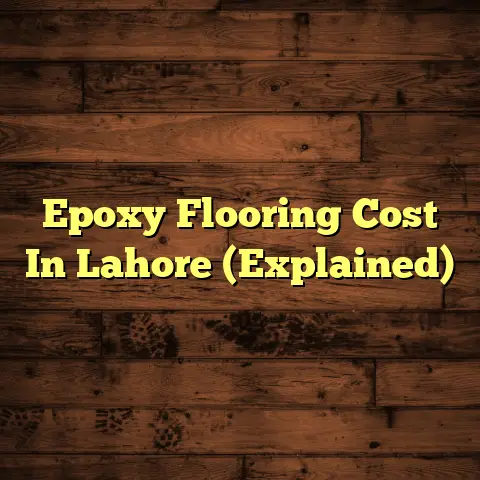Green Spaces: Worth It? (1 Pro You Need To Know!)
I remember a project I worked on a few years ago.
It was in a densely populated area, pretty much a concrete jungle.
The community was struggling, you could feel it in the air.
Then, a small group of residents decided to transform a derelict lot into a community garden.
At first, I was skeptical.
I thought, “Will this really make a difference?”
But as the garden grew, something amazing happened.
People started connecting.
They were sharing stories, working together, and taking pride in their little oasis.
Crime rates dropped, community spirit soared, and I saw firsthand the transformative power of a green space.
It wasn’t just about the plants; it was about the people, the connections, and the newfound sense of hope.
That’s when I had my “aha” moment.
Green spaces aren’t just nice-to-haves; they’re essential for healthy, thriving communities.
And that’s what I want to share with you today.
Section 1: Understanding Green Spaces
So, what exactly are green spaces?
Well, the term is pretty broad, but generally, it refers to any area dominated by vegetation in an urban or rural setting.
Think parks, gardens (both public and private), urban forests, green rooftops, community gardens, even greenways along rivers and trails.
Basically, anywhere where nature takes center stage.
Historically, green spaces have played a vital role in urban planning.
Even way back in ancient times, cities like Babylon and Rome had gardens and parks for recreation and aesthetic purposes.
In the 19th century, landscape architects like Frederick Law Olmsted (the guy who designed Central Park) championed the idea of creating urban parks as “lungs” for the city, providing fresh air and respite from the crowded, polluted streets.
Now, you might think green spaces are more important in urban environments, and you’d be right.
But they’re crucial in rural areas too!
They help maintain biodiversity, support agriculture, and provide recreational opportunities.
Whether you’re in the heart of a bustling city or surrounded by rolling hills, green spaces are essential for a healthy, balanced environment.
Section 2: The Psychological Benefits
of Green Spaces
Okay, let’s get into the good stuff: how green spaces affect your brain!
I’m not a psychologist, but I’ve seen enough to know that spending time in nature can do wonders for your mental health.
There’s a ton of research backing this up.
Studies have consistently linked access to green spaces with reduced stress, anxiety, and depression.
For example, a study published in Environmental Science & Technology found that people who moved to greener urban areas experienced sustained improvements in mental health. (Source: https://pubmed.ncbi.nlm.nih.gov/24502491/)
Think about it: when you’re surrounded by concrete and noise, your body is constantly in “fight or flight” mode.
But when you step into a park or garden, your senses are soothed by the sounds of nature, the sight of greenery, and the fresh air.
This activates your parasympathetic nervous system, which promotes relaxation and reduces stress hormones like cortisol.
It’s not just about stress reduction, though.
Green spaces can also boost your mood, increase your creativity, and improve your cognitive function.
Ever heard of “biophilia?”
It’s the idea that humans have an innate connection to nature, a deep-seated need to be surrounded by living things.
Edward O. Wilson, the guy who coined the term, argued that this connection is hardwired into our DNA, a result of millions of years of evolution spent living in close proximity to nature.
When we’re deprived of this connection, we suffer.
We become stressed, anxious, and disconnected.
But when we reconnect with nature, we feel a sense of peace, belonging, and well-being.
I see it all the time.
People who live near green spaces are generally happier and healthier than those who don’t.
They’re more likely to exercise, socialize, and engage with their communities.
And that, my friends, is a powerful thing.
Section 3: Environmental Impact of
Green Spaces
Alright, let’s talk about the planet!
Green spaces aren’t just good for your mental health; they’re also essential for the health of our environment.
One of the biggest benefits is biodiversity.
Green spaces provide habitat for a wide range of plants and animals, from birds and butterflies to squirrels and insects.
They create corridors that allow wildlife to move between fragmented habitats, promoting genetic diversity and reducing the risk of extinction.
But it doesn’t stop there.
Green spaces also provide a range of ecosystem services, which are the benefits that humans derive from ecosystems.
These include:
-
Air purification: Plants absorb pollutants like nitrogen dioxide and particulate matter, cleaning the air we breathe.
-
Temperature regulation: Trees provide shade and release water through transpiration, cooling the surrounding area and reducing the urban heat island effect.
-
Carbon sequestration: Plants absorb carbon dioxide from the atmosphere and store it in their tissues, helping to mitigate climate change.
-
Water management: Green spaces can absorb rainwater, reducing runoff and preventing flooding.
I’ve seen cities that have really embraced the power of green spaces to improve their environment.
Take Singapore, for example.
It’s a densely populated island nation, but they’ve made a concerted effort to integrate green spaces into their urban landscape.
They’ve created parks, gardens, and green rooftops throughout the city, and they’ve even built vertical gardens on the sides of buildings.
As a result, Singapore has become a model for sustainable urban development, with cleaner air, cooler temperatures, and a thriving biodiversity.
Another great example is Curitiba, Brazil.
In the 1970s, the city’s mayor, Jaime Lerner, implemented a series of innovative urban planning initiatives, including the creation of a network of parks and green spaces.
He transformed flood-prone areas into parks, created pedestrian-friendly zones, and invested in public transportation.
As a result, Curitiba has become one of the greenest cities in the world, with a high quality of life and a strong sense of community.
These are just a couple of examples, but they show what’s possible when cities prioritize green spaces.
Section 4: Economic Value of Green Spaces
Now, I know what you’re thinking: “This all sounds great, but what’s the economic benefit?”
Well, let me tell you, green spaces can be a major economic driver.
One of the most obvious benefits is increased property values.
Studies have shown that homes located near parks and green spaces are worth significantly more than those that aren’t.
A study by the National Recreation and Park Association (NRPA) found that parks increase property values by an average of 5%. (Source: https://www.nrpa.org/)
That might not sound like a lot, but it can add up to a significant amount of money, especially in expensive urban areas.
Green spaces can also boost tourism.
People are drawn to cities with beautiful parks and gardens, and they’re willing to spend money on hotels, restaurants, and attractions.
Think about cities like New York, London, and Paris.
Their iconic parks, like Central Park, Hyde Park, and the Jardin du Luxembourg, are major tourist destinations, generating millions of dollars in revenue each year.
But the economic benefits don’t stop there.
Green spaces can also reduce healthcare costs by improving public health.
As we discussed earlier, spending time in nature can reduce stress, anxiety, and depression.
It can also encourage people to be more active, reducing their risk of obesity, heart disease, and other chronic illnesses.
A study published in the journal Environmental Health Perspectives found that people who lived in greener neighborhoods had lower rates of cardiovascular disease, diabetes, and respiratory illness. (Source: https://ehp.niehs.nih.gov/doi/10.1289/ehp.1002377)
By investing in green spaces, cities can save money on healthcare costs and improve the overall health and well-being of their residents.
I’ve seen cities that have used green spaces to revitalize struggling neighborhoods.
For example, the High Line in New York City is a former elevated railway line that has been transformed into a beautiful public park.
It’s become a major tourist attraction, and it’s spurred economic development in the surrounding neighborhoods.
Restaurants, shops, and apartments have sprung up along the High Line, creating jobs and boosting property values.
Green spaces are not just pretty; they’re smart investments.
Section 5: Social Cohesion and
Community Building
Let’s talk about people!
Green spaces play a crucial role in fostering social interaction and community engagement.
They provide places for people to come together, meet their neighbors, and build relationships.
Think about your local park.
It’s probably a gathering spot for families, dog walkers, joggers, and people who just want to relax and enjoy the sunshine.
It’s a place where people from all walks of life can come together and share a common space.
Green spaces can also promote inclusivity and diversity.
They can be designed to be accessible to people of all ages and abilities, and they can incorporate features that reflect the cultural diversity of the community.
Community gardens, in particular, are great for fostering social cohesion.
They provide opportunities for people to work together, share knowledge, and grow their own food.
They can also be a source of pride for the community, creating a sense of ownership and belonging.
I’ve seen community-led initiatives that have transformed neglected green spaces into vibrant community hubs.
For example, in Detroit, Michigan, residents have created urban farms and gardens on vacant lots, providing fresh produce to local residents and creating opportunities for job training and community development.
These initiatives have not only improved the physical environment but have also strengthened social bonds and empowered local residents.
Green spaces are not just about plants and trees; they’re about people and communities.
Section 6: The One Pro You Need to Know
Okay, we’ve covered a lot of ground.
We’ve talked about the psychological, environmental, and economic benefits of green spaces.
But if I had to boil it down to one key pro, one reason why green spaces are so important, it would be this:
Green spaces enhance quality of life.
That’s it.
It’s a simple statement, but it encompasses everything we’ve discussed.
Green spaces improve our physical and mental health, they protect our environment, they boost our economy, and they strengthen our communities.
They create places where we can relax, recharge, and connect with nature and with each other.
They provide opportunities for recreation, education, and social interaction.
They make our cities more livable, more sustainable, and more enjoyable.
I’ve seen it firsthand.
I’ve seen how a small park can transform a neighborhood, how a community garden can bring people together, how a green rooftop can reduce energy consumption.
Green spaces are not just luxuries; they’re necessities.
They’re essential for our well-being, for the health of our planet, and for the future of our communities.
And that’s why we need to prioritize them.
Section 7: Challenges and Considerations
Now, I’m not going to pretend that creating and maintaining green spaces is easy.
Cities face a number of challenges, including:
-
Funding: Green spaces often compete with other priorities for limited public funds.
-
Urbanization: As cities grow, land becomes more scarce and expensive, making it difficult to acquire land for green spaces.
-
Maintenance: Green spaces require ongoing maintenance, including mowing, pruning, and irrigation, which can be costly.
-
Climate change: Climate change can impact green spaces through increased temperatures, droughts, and extreme weather events.
Despite these challenges, it’s important to find ways to overcome them.
We need to be creative and innovative in our approach to green space development.
We need to explore options like green roofs, vertical gardens, and pocket parks.
We need to engage communities in the planning and maintenance of green spaces.
And we need to adopt sustainable practices to ensure that our green spaces are resilient to climate change.
This means using native plants that are adapted to the local climate, conserving water through efficient irrigation techniques, and reducing the use of pesticides and fertilizers.
It’s not always easy, but it’s worth it.
Section 8: Conclusion
So, let’s recap.
We’ve talked about the many benefits of green spaces, including their positive impacts on our psychological well-being, our environment, our economy, and our communities.
We’ve explored how green spaces can reduce stress, improve air quality, increase property values, and foster social cohesion.
And we’ve identified the one key pro that underscores their worth: their unparalleled ability to enhance quality of life.
It’s clear that green spaces are not just nice-to-haves; they’re essential for healthy, thriving communities.
That’s why it’s so important to recognize their value and advocate for their preservation and expansion in urban environments.
We need to support policies that promote green space development, we need to invest in the maintenance of existing green spaces, and we need to engage our communities in the planning and management of green spaces.
Call to Action
So, what can you do?
Well, the first step is to simply engage with your local green spaces.
Visit your local park, take a walk in the woods, or volunteer at a community garden.
Experience the benefits of nature firsthand and see for yourself the positive impact that green spaces can have on your life.
You can also advocate for more green initiatives in your community.
Attend city council meetings, write letters to your elected officials, and support organizations that are working to protect and expand green spaces.
Every little bit helps.
Remember, green spaces are not just for us; they’re for future generations.
We have a responsibility to protect and preserve them for the benefit of all.
I’ll leave you with this quote from the great landscape architect, Frederick Law Olmsted:
“The enjoyment of scenery employs the mind without fatigue and yet exercises it; tranquilizes it and yet enlivens it; and thus, through the influence of the mind over the body, gives the effect of repose and invigoration to the whole system.”
Let’s create more green spaces and build a better future for ourselves and for our planet.
Are you with me?





